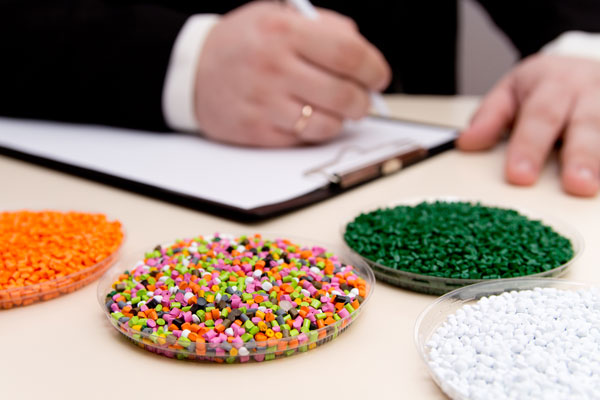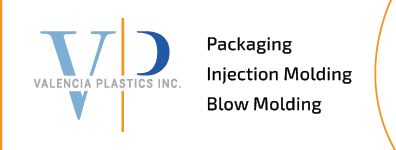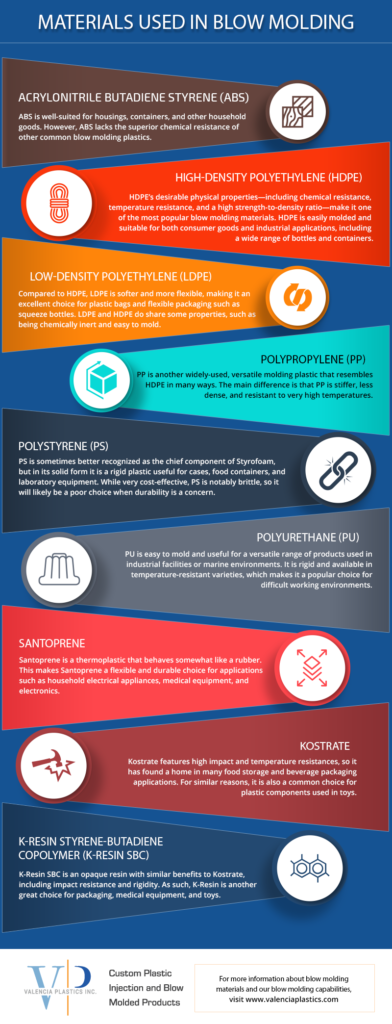Materials Used in Injection Molding and Blow Molding

Valencia Plastics draws on decades of manufacturing experience to provide premium molded plastic products for a diverse set of industry clients. As a full-service provider, we work closely with your team from the moment you request a quote to ensure that your needs are met and questions answered.
Materials Used in Blow Molding
Our blow molding capabilities extend to small and large parts using single or multi-part molds, including both air needle and blow pin models. The exact techniques used for a given project depend largely on the complexity and desired physical characteristics required by the design. The material selection process can be similarly complicated and often requires professional guidance for optimal results.
Acrylonitrile Butadiene Styrene (ABS)
ABS is well-suited for housings, containers, and other household goods. However, ABS lacks the superior chemical resistance of other common blow molding plastics.
High-Density Polyethylene (HDPE)
HDPE’s desirable physical properties—including chemical resistance, temperature resistance, and a high strength-to-density ratio—make it one of the most popular blow molding materials. HDPE is easily molded and suitable for both consumer goods and industrial applications, including a wide range of bottles and containers.
Low-Density Polyethylene (LDPE)
Compared to HDPE, LDPE is softer and more flexible, making it an excellent choice for plastic bags and flexible packaging such as squeeze bottles. LDPE and HDPE do share some properties, such as being chemically inert and easy to mold.
Polypropylene (PP)
PP is another widely-used, versatile molding plastic that resembles HDPE in many ways. The main difference is that PP is stiffer, less dense, and resistant to very high temperatures.
Polystyrene (PS)
PS is sometimes better recognized as the chief component of Styrofoam, but in its solid form it is a rigid plastic useful for cases, food containers, and laboratory equipment. While very cost-effective, PS is notably brittle, so it will likely be a poor choice when durability is a concern.
Polyurethane (PU)
PU is easy to mold and useful for a versatile range of products used in industrial facilities or marine environments. It is rigid and available in temperature-resistant varieties, which makes it a popular choice for difficult working environments.
Santoprene
Santoprene is a thermoplastic that behaves somewhat like a rubber. This makes Santoprene a flexible and durable choice for applications such as household electrical appliances, medical equipment, and electronics.
Kostrate
Kostrate features high impact and temperature resistances, so it has found a home in many food storage and beverage packaging applications. For similar reasons, it is also a common choice for plastic components used in toys.
K-Resin Styrene-Butadiene Copolymer (K-Resin SBC)
K-Resin SBC is an opaque resin with similar benefits to Kostrate, including impact resistance and rigidity. As such, K-Resin is another great choice for packaging, medical equipment, and toys.
Materials Used in Injection Molding
Many of the same materials used in blow molding are also good choices for injection molding, including ABS, HDPE, PS, PU, Santoprene, PP, and LDPE. There are a range of additional materials that are more uniquely suited for the solid products produced with injection molding, such as:
Acrylic
Acrylic is well-regarded for a combination of its glass-like appearance and resistance to wear, scratching, and UV exposure. Acrylic also resists holding stains or odors, making it a common material for food and beverage applications.
Acetal
Acetal is most commonly chosen for its physical properties. It is tough and strong, and tends to withstand friction without abrasion. Along with temperature resistance, these qualities render acetal a common material for mechanical and automotive applications.
Delrin (Polyoxymethylene)
Delrin is another material that is known for its stiffness and low friction. Its strength such that it can replace metal in some applications.
Fortron Polyphenylene Sulfide (PPS)
Fortron PPS is a durable material engineered to withstand high temperatures and chemical exposures. Like Delrin, Fortron is also very strong and stiff, and therefore an ideal candidate for demanding industrial, electrical, and automotive applications.
Nylon 6/6
Nylon 6/6 is another plastic that can replace metal in certain environments due to its strength and high melting point. It also boasts beneficial chemical, abrasion, and impact resistances, as well as desirable electrical properties.
Polyetheretherketone (PEEK)
PEEK is one of the most popular resins available for injection molding. Its versatility comes from tolerance to chemicals, radiation, and high temperatures, so it too can replace metal components in many medical, automotive, and industrial environments.
Poly Vinyl Chloride (PVC)
PVC thermoplastics are noted for their durability, dimensional stability, and resistances to flame, chemicals, and abrasion. This well-rounded combination of properties makes PVC very common in injection molding.
Polycarbonate (PC)
PC plastics are distinguished by the exemplary impact resistance that makes them crucial in many bulletproof “glass” installations. PC is used more broadly in products that need to withstand pressure or deformation without cracking.
Polyester
Polyester thermoplastics, like PVC, present a strong suite of resistances along with strength and dielectric properties. This makes them ideal for many injection molding purposes.
Ultem
Ultem is a heavy-duty plastic exhibiting high tensile strength along with excellent thermal and chemical stability. Despite being extremely durable, Ultem is also easy to mold and machine, so it is versatile material for demanding industrial applications.
Urethane
Urethane is a cost-effective option for high-volume runs, and its low cost does not come at the expense of performance. On the contrary, urethane allows engineers to achieve precise tolerances and complex shapes that would be difficult to accomplish with other materials.
Valox Resin / Polybutylene Terephthalate (PBT)
Like other crystalline plastics, Valox PBT limits friction and moisture absorption, increasing the working life of a molded component. Various grades are available with different properties.
Why Molding Material Matters
Choosing the wrong material can lead to premature component failure and consequences ranging from inconvenient to extremely costly. Contact Valencia Plastics today to begin your free expert consultation and learn more about material selection and other factors that dictate the success of your plastic molding project.

